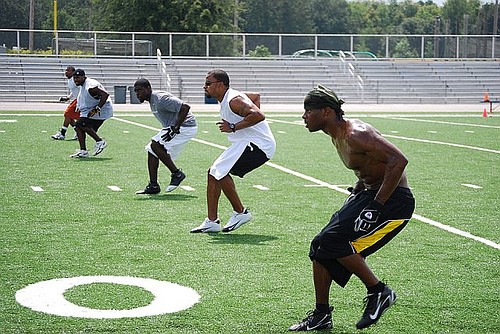

Introduction:
Athletes within the modern era face a range of challenges in comparison to previous decades. One of the main reasons for this is the advancement in technology. Within elite sport there is huge investment from external sponsors and the pressure to measure and optimise performance. Essentially as coaches our role is to improve the physical, skill and mental capacity of the player. Due to this there has been a shift in focus on athlete’s wellbeing, as it is perceived that factors such as sleep, mood and general wellbeing can influence performance.
Athletes mental health has been well documented in various sports with many athletes suffering with depression, stress and anxiety just from playing in high level sport. Combine this with personal life circumstances such as relationship issues, or family bereavement for example and this can elevate stressors and negatively impact on playing performance.
The advancement in player monitoring has become popular with the use of tablets, mobile phones and specific apps which have been designed to record key metric data such as;
- Sleep
- Training Monotony
- Health
- Mood
- Hydration Level
- Perceived Muscle Soreness
- Anxiety
- Stress

I have often heard coaches talking about pillars of performance, emphasising the particular aspects such as physical, technical, tactical,
mental and lifestyle. Some coaches have emphasised that if one of these pillars is not stable then essentially the foundation can collapse
as they are all integrated and dependent upon each other.
So, we must ask ourselves what is the point of Athlete Wellness monitoring?
The main principles are to evaluate how an athlete is responding to the coach’s systems being adopted with respect to physical and mental capacity development. This essentially ties in with the efficiency of the training programming. The second principle is to identify if an athlete is effectively recovering and adapting to the stimuli being presented through the coaching system being delivered. Essentially if their wellness scores are deteriorating then we would expect a decline in the performance being delivered.
This is where wellness tracking can be beneficial. Athlete monitoring keeps a careful eye on training stress, monotony, fatigue, load and athlete recovery to give a complete picture of recovery and readiness.
There is a wealth of research that claim that there is a relationship between general well being and performance, recovery, injury risk and
other training factors. Within elite sport there are many measures that are used to monitor an athlete’s performance such as force deck jump
data, strength scores, subjective questionnaires, chronic and acute workloads, GPS data and so on.

The work done during training can be objectively measured by an external load, which can take the form of GPS data distance covered (km), collisions, number of accelerations and decelerations, maximum speed, or metabolic power expressed. The internal load is expressed by the total of psychophysiological stress resulting from the external load. Data such as wellness monitoring generally relate to internal load and how the athlete perceives themselves, such as a rating scale of the session difficulty or their mood and sleep for example. This provides measurable data on physiological and psychological fatigue, which may be explored to identify anomalies that may indicate an increased risk of injury or a loss in performance.
From my own personal experience of working with Intercounty Gaelic Football teams I had an athlete that suffered with gambling addiction and
essentially lost a lot of money financially, which was a driver in anxiety, stress and mental health issues. Fortunately, this player had a
good family network that was able to pick up on this and were able to aid with psychological help. At that time wellness monitoring was not
implemented and this essentially transferred to his lifestyle and performance resulting in the player dropping out of favour with coaches
and ultimately resulting in him being dropped from the squad. If for instance the wellness monitoring was being used then potentially there
could have been early detection and some intervention. This example may seem a bit drastic but it’s a reality of life. Another example more
recently was when a squad player studying for University final exams reported significantly higher levels of stress, lack of sleep and
increased moodiness during the week leading up to his exams which essentially filtered into his decrease in performance at training that
week with respect to jump and strength metric.
However, despite having its uses there are potentially some issues with wellness monitoring. There is always the problem that athletes can
manipulate data or potentially might not tell the truth of how they actually feel. In an ideal world it’s a bomb proof method of monitoring
internal load of an athlete.

A term that I have read in the literature is “Conscious bias” and this occurs when athletes over report positive reactions and under report
negative reactions. Some athletes may report feeling great to look like they are coping better than another athlete etc. There is also the
issue of designing the questions in a manner to gain the best insight as to how they feel without overloading them I have found that players
sometimes see it as a chore and potentially don’t buy in to the system. Getting athletes to provide reliable data is a major difficulty for
monitoring programmes.
There is no perfect monitoring method, and athletes' performance will always show modest rises and falls as a result of many measurements. A player-monitoring tool, on the other hand, allows players to communicate with a coach on a monthly or daily basis via psychometric data such as stress levels, sleep duration, sleep quality, muscle discomfort, and training monotony. The interpretation of the data is critical, and when to intervene is the essential question for instance if a player’s stress level increase from 5% to 10% or by 30%.
Each athlete reacts differently to loading, type of training, stress and recovery. What works for one athlete may not work for another. Universal wellness criteria are difficult to set because of individual reactions. Understanding the data is a complicated interplay and identifying a factor's influence on an athlete's well-being is tough. It also must be questioned the comprehensive representation of emotional and psychological elements may prove tricky in numerical metrics.

My personal experience with wellness monitoring started with an Intercounty Gaelic Football team back in 2013 in an attempt to monitor players performance in more detail. After detailed discussions with the service provider we devised the questions and scales such as DOMs, sleep, mood, hydration, anxiety and an RPE scale for load monitoring. Following a subscription, we attempted to implement this for all 40 squad players. After reinforcing the worth of this information with the coaching team unfortunately it never received the backing in which we desired and only 11 athletes filled the data in over an 8-week period. Following this after many discussions it was decided by management to cancel the subscription as the players felt they didn’t have time to fill in the data on a daily basis.
Unfortunately, the lack of buy in from the players could have potentially been to various factors such as they potentially didn’t want their information critiqued in depth or the commitment of filling it in daily was too much effort on top of their regular life commitments. It potentially could also be due to this being a new intervention sometimes players and coaches do not like change and didn’t want to enforce it.
On the contrary to this in recent times athletes are more aware of their wellbeing and potentially are more open, in recent years teams that I have worked with are much more App or tech savvy and have a much better buy in with apps and watches such as whoop which provide data on their daily wellbeing. Despite there being some inconsistencies there is no perfect tool for measuring athlete’s wellbeing, however it can be a useful adjunct to sit alongside more advanced multidisciplinary outcome measures. For example, if the S&C coach is monitoring GPS, jump mat data and resting heart rate for loading it gaining perceived exertions may be useful. Furthermore, a sport psychologist may use more in-depth analysis when conducting a psychological evaluation of the player but can also monitor on a more day to day basis by analysing stress, mood and anxiety scores through a wellness app.
I think this links in to the multidisciplinary team being transparent and communicating effectively with respect to the overall athlete’s wellbeing and being able to act on data as a group if they feel there is a significant underlying issue such as player burnout or personal issues disrupting the athlete’s performance.
Thanks for reading.... Chris



.jpg)